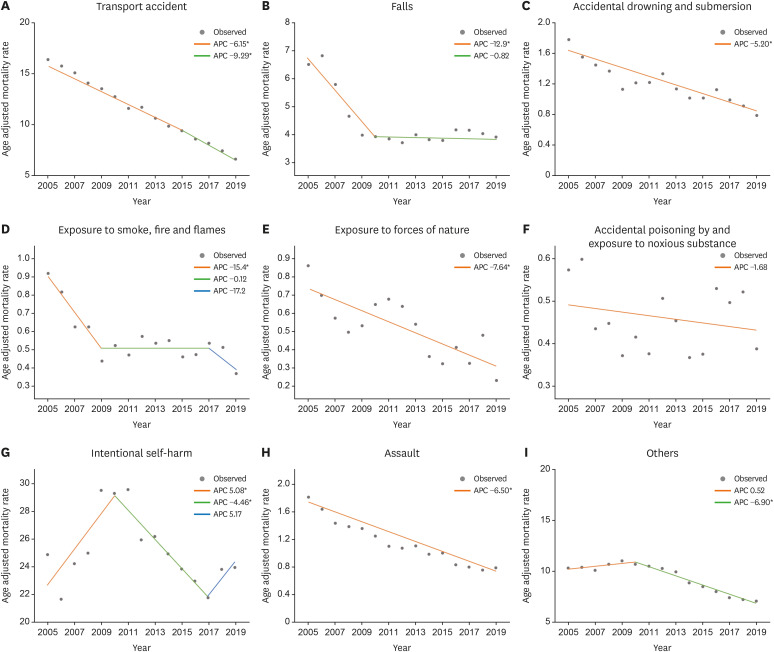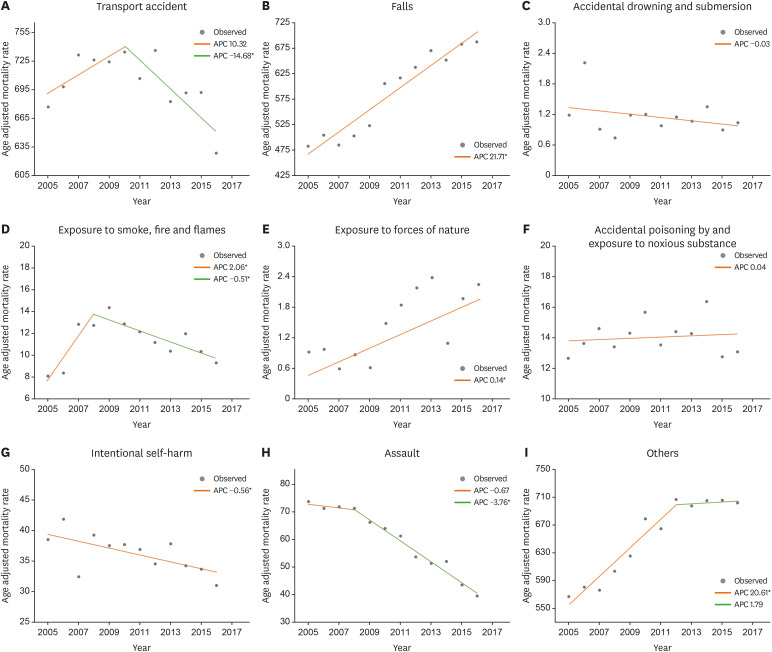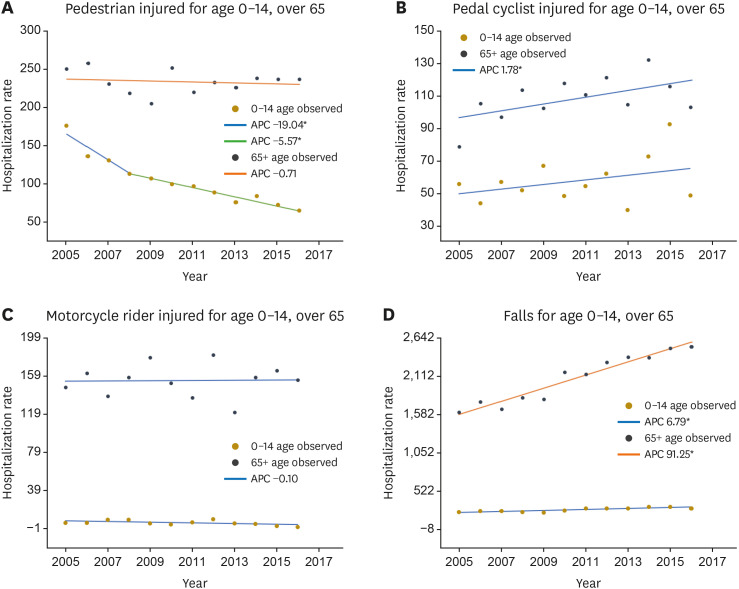J Korean Med Sci.
2022 Jan;37(3):e10. 10.3346/jkms.2022.37.e10.
Joinpoint Regression About Injury Mortality and Hospitalization in Korea
- Affiliations
-
- 1Department of Preventive Medicine, College of Medicine, Ewha Womans University, Seoul, Korea
- 2Graduate Program in System Health Science and Engineering, Ewha Womans University, Seoul, Korea
- 3Department of Preventive and Management, Inha University School of Medicine, Incheon, Korea
- 4National Cancer Control Institute, National Cancer Center, Goyang, Korea
- 5Advanced Biomedical Research Institute, Ewha Womans University Seoul Hospital, Seoul, Korea
- 6Center of Public Healthcare, National Medical Center, Seoul, Korea
- 7Department of Emergency Medicine, Hallym University Dongtan Sacred Heart Hospital, Hwaseong, Korea
- KMID: 2524888
- DOI: http://doi.org/10.3346/jkms.2022.37.e10
Abstract
- Background
Injury is a social problem that causes health and property losses, and it is important to identify the size and trend of injury for efficient prevention and management. Therefore, this study analyzed the trends in injury mortality and hospitalization rates from 2005 to 2019 in Korea.
Methods
Using mortality data by Statistics Korea and Korea National Hospital Discharge In-depth injury survey by the Korea Disease Control and Prevention Agency (KDCA), age standardized rates were calculated for death and hospitalization to analyze trends and annual changes with the joinpoint regression model. In addition, annual changes in the hospitalization rate of the transport accident and fall injuries by age group were analyzed, which are the major causes of injuries.
Results
From 2005 to 2019, the injury mortality rate has been on the decline, but the injury hospitalization rate has been on the rise. The annual rate of change varied depending on the injury mechanism, but the mortality rate tended to decrease or remain similar level, while the rate of hospitalization has steadily increased. In addition, by age group, injury mortality and hospitalization rates were high in the elderly. In particular, the hospitalization rate of the elderly was higher when comparing the hospitalization rate of the children in transport accidents and falls. Pedestrian transport accidents tended to decrease under the age of 15, but remained similar for those aged 65 and older, and bicycle accidents tended to increase in both groups. In addition, hospitalization rates were higher in the fall, with both groups showing a statistically significant increase in hospitalization rates caused by falls.
Conclusion
This study analyzed the trend of injury mortality and hospitalization and found that transport accidents and falls may vary depending on the means or age of the accident. Since injury is a big social problem that is a burden of disease, safety education and legal sanctions for injury prevention should be further improved in the future, especially by prioritizing vulnerable groups by age and detailed mechanisms of injury.
Keyword
Figure
Reference
-
1. Hay SI, Abate KH, Abbafati C, Abbas KM, Abd-Allah F, Abdulkader RS, et al. Global, regional, and national disability-adjusted life-years (DALYs) for 333 diseases and injuries and healthy life expectancy (HALE) for 195 countries and territories, 1990–2016: a systematic analysis for the Global Burden of Disease Study 2016. Lancet. 2017; 390(10100):1260–1344. PMID: 28919118.2. Haddon W Jr. The changing approach to the epidemiology, prevention, and amelioration of trauma: the transition to approaches etiologically rather than descriptively based. Am J Public Health Nations Health. 1968; 58(8):1431–1438. PMID: 5691377.
Article3. Krug EG, Sharma GK, Lozano R. The global burden of injuries. Am J Public Health. 2000; 90(4):523–526. PMID: 10754963.
Article4. OECD.Stat. Health status: external causes of mortality. Updated 2020. Accessed 2020 September 28. https://stats.oecd.org/ .5. Hong S, Kim B, Bae J, Oh J, Jo M, Kim S, et al. Epidemiological characteristics of injured inpatients in Korea. Public Health Wkly Rep. 2015; 11(11):310–318.6. Lee YR, Cho B, Jo MW, Ock M, Lee D, Lee D, et al. Measuring the economic burden of disease and injury in Korea, 2015. J Korean Med Sci. 2019; 34(Suppl 1):e80. PMID: 30923489.
Article7. Kim S. Epidemiology and control of injury. J Prev Med Public Health. 2005; 38(2):125–131. PMID: 16315748.8. Yoon J, Oh IH, Seo H, Kim EJ, Gong YH, Ock M, et al. Disability-adjusted life years for 313 diseases and injuries: the 2012 Korean Burden of Disease Study. J Korean Med Sci. 2016; 31(Suppl 2):S146–S157. PMID: 27775252.
Article9. Hong SO, Kim B, Jo J, Kwon Y, Lee YK, Kim Y. Main results of the Korea national hospital discharge in-depth injury survey, 2004–2016. Epidemiol Health. 2020; 42:e2020044. PMID: 32580533.10. Park H. Development of Preventive Indicators and Questionnaire of Injuries among Children and Adolescents. Cheongju: Korea Disease Control and Prevention Agency;2012.11. Kim MS. Child safety and child injury prevention strategies. Health Welf Policy Forum. 2016; 44–61.12. Becker C, Gebhard F, Muche R, Scheible S, Nikolaus T. Epidemiology of accidental falls in the elderly. Z Orthop Ihre Grenzgeb. 1999; 137(6):482–485. PMID: 10666853.13. Kwon YJ, Ryu SY, Shin SO, Chun IA, Park MS, Shim JS. The injury and its related factors in the elderly using the data of 2008 community health survey. J Agric Med Community Health. 2014; 39(1):1–13.
Article14. Heinrich HW, Petersen D, Roos N, Brown JV, Hazlett S. Industrial Accident Prevention. 5th ed. New York, NY: McGraw-Hill;1980. p. 1–468.15. World Health Organization. Injuries and Violence: the Facts. Geneva: WHO;2004.16. Wadman MC, Muelleman RL, Coto JA, Kellermann AL. The pyramid of injury: using ecodes to accurately describe the burden of injury. Ann Emerg Med. 2003; 42(4):468–478. PMID: 14520317.17. Han H, Park B, Park B, Park N, Park JO, Ahn KO, et al. The pyramid of injury: estimation of the scale of adolescent injuries according to severity. J Prev Med Public Health. 2018; 51(3):163–168. PMID: 29886712.
Article18. Kim KS, Kim SD, Lee SH. Trend of mortality rate and injury burden of transport accidents, suicides, and falls. J Prev Med Public Health. 2012; 45(1):8–13. PMID: 22389753.
Article19. Lee EM, Lee H, Kim H. Discharge rates and treatment outcomes of injured patients in South Korea, 2005–2016: findings from the Korean National Hospital Discharge In-depth Injury Survey. Korean Public Health Res. 2020; 46(2):45–59.20. Kim A, Song H, Park N, Choi S, Cho J. Injury pyramid of unintentional injuries according to sex and age in South Korea. Clin Exp Emerg Med. 2018; 5(2):84–94. PMID: 29973033.
Article21. Kim Y, Ro YS, Shin SD, Song KJ, Hong KJ. Association between time of injury and injury severity after pediatric pedestrian injury. J Korean Soc Emerg Med. 2018; 29(1):76–84.22. Kehoe A, Smith JE, Edwards A, Yates D, Lecky F. The changing face of major trauma in the UK. Emerg Med J. 2015; 32(12):911–915. PMID: 26598629.
Article23. Dinh MM, Roncal S, Byrne CM, Petchell J. Growing trend in older patients with severe injuries: mortality and mechanisms of injury between 1991 and 2010 at an inner city major trauma centre. ANZ J Surg. 2013; 83(1-2):65–69. PMID: 22882777.
Article24. Eun-mi L, Hyewon L, Hyekyung K. Discharge rates and treatment outcomes of injured patients in South Korea, 2005–2016: findings from the Korean national hospital discharge in-depth injury survey. Korea Inst Health. 2020; 46(2):45–59.25. Yang BM, Kim J. Road traffic accidents and policy interventions in Korea. Inj Control Saf Promot. 2003; 10(1-2):89–94. PMID: 12772491.
Article26. Lee JW. Factors affecting hospitalized children’s falls – using data in the national hospital discharge in-depth survey. J Korea Acad Ind Coop Soc. 2020; 21(7):510–516.27. Jo KH, Park J, Ryu SY. The effects of mental health on recurrent falls among elderly adults, based on Korean community health survey data. Epidemiol Health. 2020; 42:e2020005. PMID: 32023776.
Article28. Young L, Ahmad H. Trauma in the elderly: a new epidemic? Aust N Z J Surg. 1999; 69(8):584–586. PMID: 10472913.
Article29. Mayo Clinic. Fall prevention: simple tips to prevent falls. Updated 2019. Accessed September 14, 2021. https://www.mayoclinic.org/healthy-lifestyle/healthy-aging/in-depth/fall-prevention/art-20047358 .30. James SL, Castle CD, Dingels ZV, Fox JT, Hamilton EB, Liu Z, et al. Global injury morbidity and mortality from 1990 to 2017: results from the global burden of disease study 2017. Inj Prev. 2020; 26(Supp 1):i96–114. PMID: 32332142.
- Full Text Links
- Actions
-
Cited
- CITED
-
- Close
- Share
- Similar articles
-
- Disease burden and epidemiologic characteristics of injury in Korea
- Risk factors for in-hospital mortality in patients starting hemodialysis
- Descriptive Analysis of Gastric Cancer Mortality in Korea, 2000-2020
- An exploratory study of risk factors for pressure injury in patients undergoing spine surgery
- Weekend Admission and Mortality in Patients With Traumatic Brain Injury: A Meta-analysis




